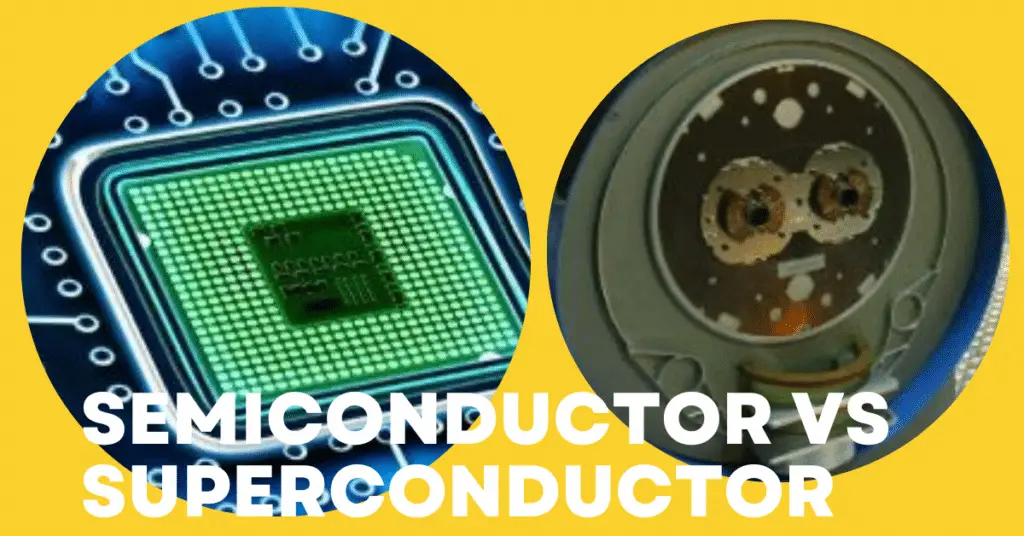In this article, we will discuss the differences between semiconductor and superconductor and their basic description.
Based on electrical conductivity, engineering materials are majorly classified into conductors, insulators, semiconductors, and superconductors. Conductors are the materials that allow an electric current to flow through them. Insulators are those materials that completely restrict the flow of current through them. Semiconductors are those materials that have electrical conductivity in between that of conductors and insulators. Superconductors are those having zero electrical resistance.

Since this article is dedicated to explaining the differences between semiconductors and superconductors. So let us discuss the basics of semiconductors and superconductors in some more detail.
What is Semiconductor?
A semiconductor is a type of engineering material that has electrical conductivity less than conductors but greater than insulators. Thus, we can say semiconductors have electrical conductivity or resistivity between conductors and insulators.
Semiconductor materials are widely used in the manufacturing of electronic devices like ICs, transistors, diodes, etc.
In practice, semiconductors are classified into two types namely, intrinsic semiconductors and extrinsic semiconductors. Semiconductors in their pure form are referred to as intrinsic semiconductors. While semiconductors formed by adding impurities are called extrinsic semiconductors. Intrinsic semiconductors have lower electrical conductivity as compared to extrinsic semiconductors.
Extrinsic semiconductors are also classified into two types, i.e. P-Type semiconductor and N-Type semiconductor. P-type semiconductors are those that have free holes as the charge carries, i.e. have excess holes (positive charge). Whereas, N-type semiconductors are those having electrons in excess. Examples of semiconductor materials are silicon, germanium, etc.
What is Superconductor?
Engineering material that losses all its electrical resistivity below a certain temperature is known as a superconductor. In simple words, a material having zero electrical resistance is known as a superconductor.
Hence, the superconductor allows the flow of electric current without any loss of energy. Therefore, ideally, a superconductor has very high (tending to infinity) conductivity.
Superconductors are classified into two types, i.e. Type I Superconductors and Type II Superconductors. Type I superconductors are those that behave as conductors at room temperature but below a critical temperature, these allow an uninterrupted flow of electric current.
On the other hand, Type II superconductors are those that are not good conductor at room temperature but attains superconductivity below a critical temperature.
In practice, some metallic compounds and alloys are examples of superconductors.
After getting insights into the basics of semiconductors and superconductors, now let us discuss the differences between them.
Difference between Semiconductors and Superconductors
The following are the important differences between semiconductors and superconductors:
| Key | Semiconductor | Superconductor |
| Definition | Materials that have resistivity between conductors and insulators are called semiconductors. | Materials that have resistivity equal to zero are called superconductors. |
| Electrical conductivity | Semiconductors have moderate electrical conductivity. | Superconductors have very high electrical conductivity. |
| Forbidden energy gap | For semiconductors, the forbidden energy gap is ranging between 0.25 eV and 2.5 eV. | For superconductors, the energy band gap is greater than 2.5 eV. |
| Conduction | Semiconductors conduct electric current by the movement of electrons and holes. | Superconductors conduct electric current due to the movement of electrons. |
| Energy loss | Semiconductors have moderate energy losses. | Superconductors have no energy loss due to zero resistance. |
| Types | There are two types of semiconductors, i.e. intrinsic semiconductors and extrinsic semiconductors. Extrinsic semiconductors are further classified into two types namely, P-type and N-type. | Superconductors are classified into two types namely, Type I superconductors and Type II superconductors. |
| Examples | Examples of semiconductor materials are silicon, germanium, GaAs, etc. | Examples of superconductors are metallic compounds and alloys. |
| Applications | Semiconductors are extensively used in the manufacturing of electronic devices like transistors, diodes, ICs, etc. | Superconductors are used in manufacturing high-speed connections in computer ICs, making superconducting coils, MRIs, etc. |
Hence, this is all about semiconductors and superconductors, and their differences.